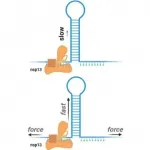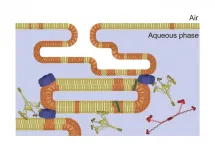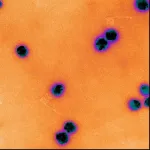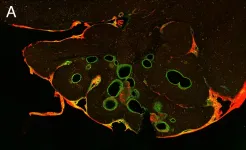Tool encoded in coronaviruses provides a potential target for COVID-19
Viruses make copies of themselves during an infection, and new research sheds light on one of the coronavirus molecules that is important for this process, providing a potential drug target that could work for Covid-19 and other coronavirus outbreaks too.
2021-02-23
(Press-News.org) ROCKVILLE, MD - Coronaviruses exploit our cells so they can make copies of themselves inside us. After they enter our cells, they use our cell machinery to make unique tools of their own that help them generate these copies. By understanding the molecular tools that are shared across coronaviruses, there is potential to develop treatments that can not only work in the current COVID-19 pandemic, but in future coronavirus outbreaks as well. Rockefeller University researchers in the labs of Tarun Kapoor and Shixin Liu, including postdoctoral associate Keith Mickolajczyk, recently published their study of one of these molecular tools, which is a potential drug target. They will present their research on Tuesday, February 23 at the 65th Annual Meeting of the Biophysical Society.
During a viral infection, viruses make copies of themselves inside their host, and viruses carry genetic instructions for several tools in order to do so. One of those tools is called a helicase--all organisms have helicases that unwind the genetic information so it can be read or copied. Mickolajczyk had been studying helicases and other molecular motors when the COVID-19 pandemic hit and turned his attention to a helicase encoded in the genome of SARS-CoV-2 (the virus that causes COVID-19), called nsp13.
Mickolajczyk and colleagues investigated the mechanism that individual nsp13 molecules use to unwind genetic material, and their study marks the first single-molecule unwinding experiments to ever be done on a coronavirus helicase. They found that nsp13 is a relatively weak helicase, meaning it needs assisting mechanical forces to be activated, and other viral molecules may help it. They also found that nsp13 did not act like a Hepatitis C virus helicase with a similar shape, and instead acted more like ring-shaped helicases found in bacteriophages (viruses that infect bacteria).
Because coronaviruses have helicases that are very similar to nsp13, it is valuable to understand how this molecule works. "If we can come up with viral therapeutics that hit nsp13, we can have a first line of defense when new coronaviruses potentially erupt and cause new epidemics or pandemics in the future. Understanding this mechanism now can help us design inhibitors that can be treatments against coronaviruses," Mickolajczyk says.
Their results, Mickolajczyk says, can provide insights that can be leveraged for drug discovery efforts. By inhibiting nsp13, a drug could prevent coronaviruses from making copies of themselves, thereby halting infections and stopping or preventing a pandemic.
INFORMATION:
[Attachments] See images for this press release:

ELSE PRESS RELEASES FROM THIS DATE:
2021-02-23
ROCKVILLE, MD - A tenth of all intensive care unit patients worldwide, and many critical patients with COVID-19, have acute respiratory distress syndrome (ARDS). Therapeutic hypothermia, an intentional cooling of the body, has been suggested as a way to improve ARDS. New research by Chiara Autilio and colleagues in the lab of Jesus Perez-Gil at the Complutense University of Madrid shows not only how therapeutic hypothermia works in the lungs at the molecular level, but also why it could be successfully applied to ARDS. Autilio and her colleagues' work was published in Nature Scientific Reports in January 2021 and will be presented ...
2021-02-23
ROCKVILLE, MD - The remarkable genetic scissors called CRISPR/Cas9, the discovery that won the 2020 Nobel Prize in Chemistry, sometimes cut in places that they are not designed to target. Though CRISPR has completely changed the pace of basic research by allowing scientists to quickly edit genetic sequences, it works so fast that it is hard for scientists to see what sometimes goes wrong and figure out how to improve it. Julene Madariaga Marcos, a Humboldt postdoctoral fellow, and colleagues in the lab of Professor Ralf Seidel at Leipzig University in Germany, found a way to analyze the ultra-fast movements of CRISPR enzymes, which will help researchers understand how they recognize their target sequences in hopes of improving the specificity. Madariaga Marcos will present ...
2021-02-23
New compound targets neurons that initiate voluntary movement
After 60 days of treatment, diseased brain cells look like healthy cells
More research needed before clinical trial can be initiated
CHICAGO and EVANSTON--- Northwestern University scientists have identified the first compound that eliminates the ongoing degeneration of upper motor neurons that become diseased and are a key contributor to ALS (amyotrophic lateral sclerosis), a swift and fatal neurodegenerative disease that paralyzes its victims.
In addition to ALS, upper motor neuron degeneration also results in other motor neuron diseases, such as hereditary spastic paraplegia (HSP) and primary lateral sclerosis (PLS).
In ALS, movement-initiating nerve cells in the brain (upper motor neurons) and muscle-controlling ...
2021-02-23
According to a 2017 UCLA study, students with ADHD make up about 6% of the college student population and represent the most common type of disability supported by college disability offices. But are these students receiving enough academic support from their institutions? Despite ADHD being prevalent among college students, there has been little research focused on how having ADHD impacts the transition to college and ongoing academic success. Until now.
New research from George DuPaul, professor of school psychology and associate dean for research in Lehigh University's College of Education, and colleagues confirms students with ADHD face consequential challenges in succeeding and completing ...
2021-02-23
DURHAM, N.C. -- Younger, smaller trees that comprise much of North America's eastern forests have increased their seed production under climate change, but older, larger trees that dominate forests in much of the West have been less responsive, a new Duke University-led study finds.
Declines in these trees' seed production, or fecundity, could limit western forests' ability to regenerate following the large-scale diebacks linked to rising temperatures and intensifying droughts that are now occurring in many states and provinces.
This continental divide, reported for the ...
2021-02-23
In recent years, researchers have discovered ways to remove specific fears from the brain, increase one's own confidence, or even change people's preferences, by using a combination of artificial intelligence and brain scanning technology. Their technique could lead to new treatments for patients with conditions such as post-traumatic stress disorder (PTSD), phobias or anxiety disorders.
But while this technique is extremely promising, in some individuals it remains unsuccessful. Why are there such differences in outcome? Better understanding how the brain can self-regulate its own activity patterns would go a long way toward establishing the technique for clinical use. The researchers who spearheaded this technique have thus released a unique dataset ...
2021-02-23
Peer review/Experimental study/Animals
Propranolol, a drug that is efficacious against infantile haemangiomas ("strawberry naevi", resembling birthmarks), can also be used to treat cerebral cavernous malformations, a condition characterised by misshapen blood vessels in the brain and elsewhere. This has been shown by researchers at Uppsala University in a new study published in the scientific journal Stroke.
"Up to now, there's been no drug treatment for these patients, so our results may become hugely important for them," says Peetra Magnusson of the University's Department of Immunology, Genetics and Pathology, who headed the study.
Cerebral cavernous malformations (CCMs, also called cavernous angiomas or cavernomas) are vascular lesions ...
2021-02-23
DALLAS, Feb. 23, 2021 — Women face many female-specific risks for heart disease and stroke, including pregnancy, physical and emotional stress, sleep patterns and many physiological factors, according to multiple studies highlighted in this year’s Go Red for Women® special issue of the Journal of the American Heart Association, published online today.
“Although cardiovascular disease is the leading cause of death in men and women, women are less likely to be diagnosed and receive preventive care and aggressive treatment compared to men,” said Journal of the American Heart Association Editor-in-Chief Barry London, M.D., Ph.D., Ph.D., the Potter Lambert Chair in Internal Medicine, director of the division ...
2021-02-23
Using an innovative computational approach to analyze vast brain cell gene expression datasets, researchers at MIT and Sorbonne Université have found that Huntington's disease may progress to advanced stages more because of a degradation of the cells' health maintenance systems than because of increased damage from the disease pathology itself.
The analysis yielded a trove of specific gene networks governing molecular pathways that disease researchers may now be able to target to better sustain brain cell health amid the devastating neurodegenerative ...
2021-02-23
The use of the polymeric flame retardant PolyFR in "eco-friendly" foam plastic building insulation may be harmful to human health and the environment, according to a new commentary in Environmental Science & Technology. The authors' analysis identifies several points during the lifecycle of foam insulation that may expose workers, communities, and ecosystems to PolyFR and its potentially toxic breakdown products.
With the climate crisis fueling demand for energy-efficient insulation, the production of PolyFR is increasing rapidly. That's because this flame retardant is added to all foam plastic building insulation in North America to comply with flammability codes, replacing the flame retardant ...
LAST 30 PRESS RELEASES:
[Press-News.org] Tool encoded in coronaviruses provides a potential target for COVID-19
Viruses make copies of themselves during an infection, and new research sheds light on one of the coronavirus molecules that is important for this process, providing a potential drug target that could work for Covid-19 and other coronavirus outbreaks too.





